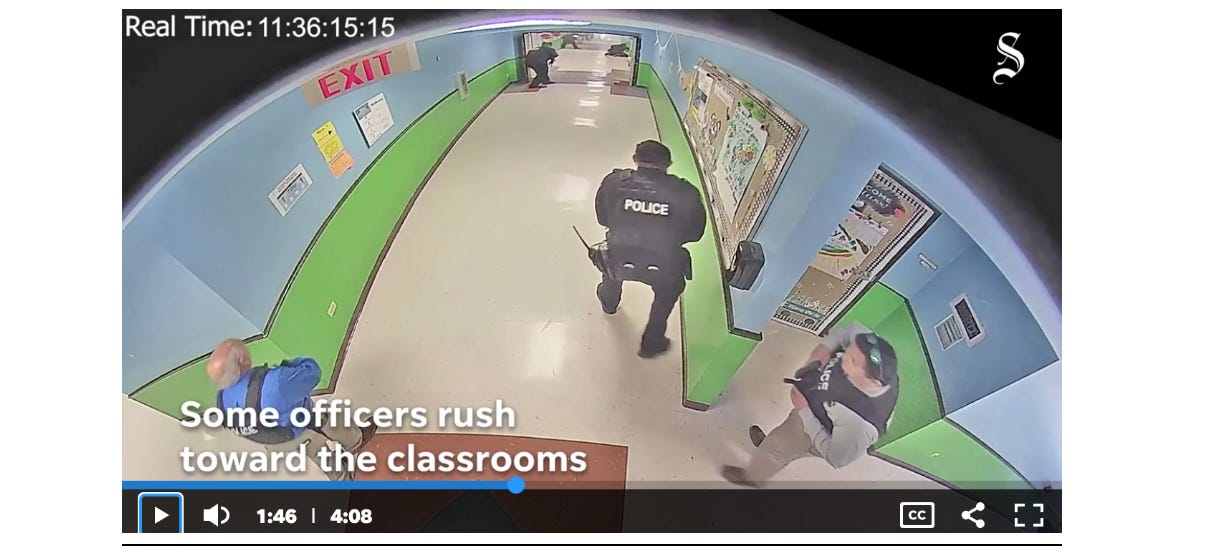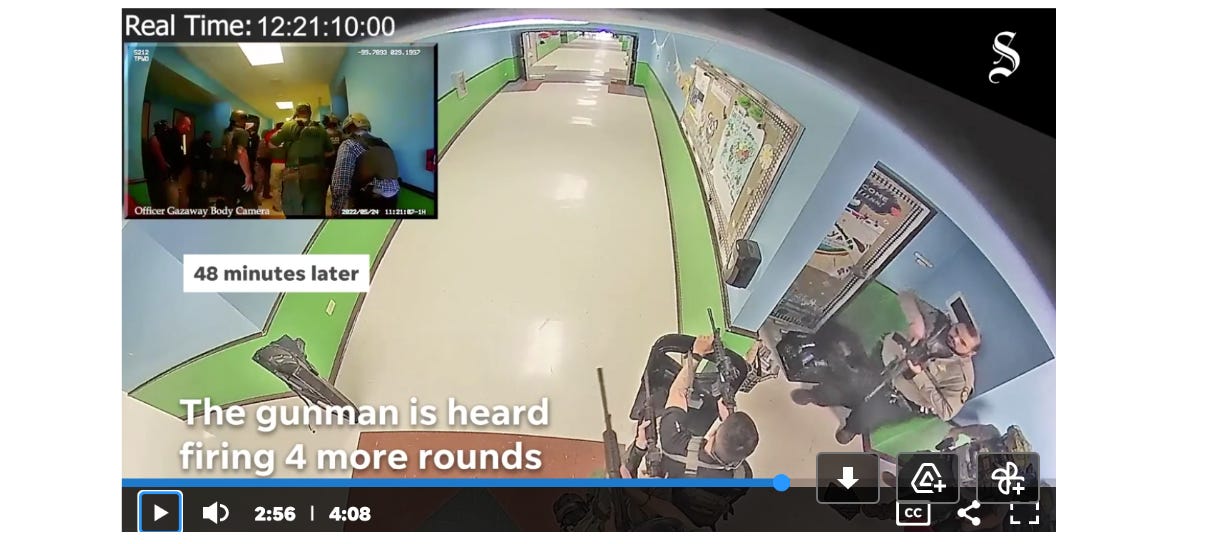Toward the sound of the guns
The Civil War, and Uvalde, Texas. Also, 7 other things worth knowing today.
Today’s newsletter will be one of the ones in which I started writing about history but then realized there’s no such thing; only an ongoing story that never really ends.
It starts with a date I’ve had marked because I thought it would give rise to something worthy to share: July 18, which will mark the 159th anniversary of the Battle of Fort Wagner in South Carolina during the Civil War.
If you’ve seen the movie Glory, with Matthew Broderick, Morgan Freeman, and Denzel Washington (in the role that won him his first Academy Award), this is the battle at the end of the film, in which the 54th Massachusetts Regiment, one of the first all-Black regiments organized during the U.S. Civil War, fought valiantly but futilely.
Within hours, 40 percent of the 54th’s soldiers were killed, wounded, or missing. The battle also included the earliest act of valor for which a Black American, Sgt. William Harvey Carney, was awarded the Medal of Honor.
If you watch the movie or study history, it becomes clear that the 54th’s objective, which involved marching across an open beach under heavy artillery fire and attacking a well-defended fort, was basically a suicide mission.
But, they did it anyway. Why?
Because they wanted to prove that Black men were as brave as any other men on the planet.
Because it was their mission.
And, because when we're tested in life, some people learn that they march to the sound of the guns—while others freeze up or even flee.
This is the story that I had in mind to write yesterday. I would have gone on more about Sgt. Harrison and Robert Gould Shaw, and the characters that Freeman and Washington played. And, I encourage people to learn about them.
But then, as sometimes happens, I found that the theme I had in mind—about people who rise to the occasion and display immense courage, and those who don’t—was illustrated vividly in the opposite by the video of the police in the Uvalde, Texas school shooting, which I finally had time to watch yesterday.
The Texas media who pried this video loose in the last few days deserve praise. Because it’s one thing to say that heavily armed police allegedly waited and waited for more than ab hour instead of charging to save children and defeat the single, deranged, untrained teenager who was slaughtering them.
It’s another thing entirely to watch it unfold, minute by minute on your screen—or even in a four-minute edited version.
If you can stomach it, I think the video is important to watch. It’s violent but removed; thank God the actual scenes of carnage aren’t included. I couldn’t bear to witness that.
But, it does give rise to perhaps the saddest, most haunting sentence ever written:
“Editor’s note: The sound of children screaming has been removed.”
Except for the sound of gunfire at the beginning, most of the video is about inertia. It’s about human failing, and guns, and the nature of evil, and mental health, and children, and who you can trust when things go about as bad as they possibly could, and who you can’t.
On the assumption that most people won’t watch the video, I’ve included five rather antiseptic screenshots below, which tell a lot of the story.
(Note that the rest of this will not make much sense if you don’t have images enabled.)
Here’s the rough timeline:
By 11:33 a.m. local time, the gunman is in the school, opening fire on children. The red arrow points to the murderer. The blue arrow points to a pupil (blurred) who happened upon the scene, but who turned and got away.
The initial gunfire goes on for at least two and a half minutes. By 11:36, the police arrive, including officers with body armor and rifles. They advance down the hallway.
A minute later, the gunman fires, and the police retreat to the safety of the far end of the hallway.
(The notation “4 minutes later” in these images refers to elapsed time since the start of the video; the police were only in the advanced position for less than a minute.)
More heavily armored officers arrive. Half an hour passes. They wait in the hallway.
The gunman fires; dozens of police continue to wait. The video shows police checking their phones and walking in and out of the frame. One officer gets some hand sanitizer from the dispenser on the wall.
Finally, 74 minutes after the first police arrived, and after 19 students and two teachers were dead, they stormed the classroom and kill the shooter.
It’s worth remembering that many parents tried to enter the school, only to be restrained by police outside. One mother reportedly drove 40 minutes, wound up in handcuffs, talked her way out if it, and then sprinted inside to save her two children before the cops in the hallway did anything.
What more is there to say at this moment? I’m not even sure of my own takeaway here, never mind what I should suggest anyone else should think.
Blame all police? Say “no, these were bad apples?”
Restrict firearms? Say “heck no; you can’t trust the police when you need them, so you have to defend yourself?”
Something else?
I’m sure readers will have thoughts in the comments. But, in what Kipling called the unforgiving minute, some people run toward the sound of the guns. Some don’t.
7 other things worth knowing today
The mayor of Uvalde is attacking the media for obtaining the video and releasing it. (CBS News)
The consumer price index, a broad measure of everyday goods and services related to the cost of living, soared 9.1% from a year ago, above the 8.8% Dow Jones estimate. That marked the fastest pace for inflation going back to November 1981. (CNBC)
A 26-year-old man in Ohio has been charged with rape after he allegedly impregnated a 10-year-old girl who then traveled to Indiana for an abortion. This case has been noteworthy for many reasons, including allegations that the story was “fake news” because no criminal investigation had been revealed when it was first reported. (Dispatch)
North Carolina has been rated by CNBC as the best state in the U.S. for business, in part because of its reputation for "putting partisanship aside" to get things done. Rounding out the top 5 are Washington, Virginia, Colorado and Texas. Last on the list: Mississippi. (My state, New Jersey, is ranked 42nd; nothing to write home about.) (CNBC)
I am fully aware that this is the opposite of a story I linked to yesterday, but: "Rents rose in the US last month at the fastest pace since 1986, helping to propel overall inflation to a fresh four-decade high." (Yahoo Finance)
Amazon admits it's been handing Ring Doorbell videos to police without owners’ consent. (Daily Beast)
NASA was named the best place to work in the federal government. (Business Insider)
Thanks for reading. Photo fair use via Youtube. Want to see all my mistakes? Click here.








I read Bill’s article, glanced at the pictures, and have no desire to watch even a moment of the video. These policemen failed. Whatever extenuating circumstances can be argued, they failed to save those children. What I think we all need to contend with, however, is that we have all failed. This is a societal sin — not merely because some 18 year old psychopath was able to get hold of a weapon, nor because the police held back rather than risk their own lives. This is on us because we are part of a society that has been cultivating a culture of death for the last 50 plus years, we’ve had a laissez fare, anything goes attitude about elevating the self above all else, and we do not cherish life. Why are we surprised by the violence? If we are, I would submit that we need to get out our echo chambers and see things for what they are. This isn’t a problem created by Second Amendment nut-jobs or liberal politicians, but by a retreat away from the true common good and personal responsibility, among other things. Shame on us. May God have mercy on us.
Shortly after this horrible tragedy, I thought about how difficult it is to teach/train/hire people with critical thinking skills who instinctively will exercise the best option despite rules, procedures, orders, and directives. In military and para-military organizations, this is particularly hard. Hierarchy and chain of command are intrinsic, yet we desire individual discernment, analysis, and assessment as core competencies. I am totally stunned by the number of law enforcement persons at this scene and that none of them felt compelled to override the orders--knowing that their were people (children) in need of their expertise. This should be a serious item of discussion in every organization. How do we balance the "order" of the organization against the risks that move us forward and are the right thing to do? Sometimes the right and logical thing means putting your life and career on the line.